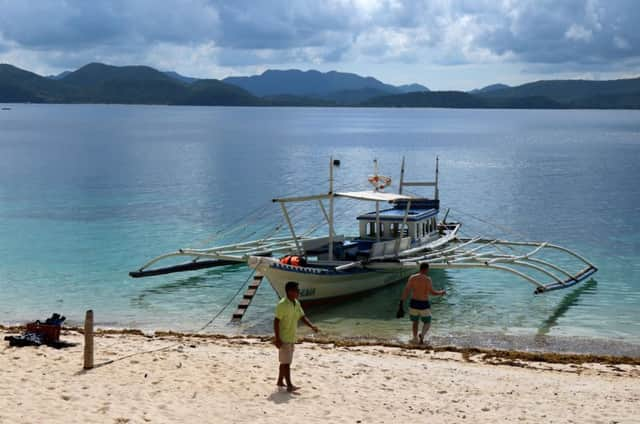Travel review: Philippines - Archipelago figure it out


The Philippines is an archipelago of approximately 7,000 isles to the south and east of mainland Asia. It’s known for its white sand beaches, clear water and dive sites, but Bohol also has heritage and culture. The island and its tiny neighbour Panglao (the two are linked by a bridge) are in the central Visayas region, just over an hour’s flight from the capital, Manila, in the north.
As the sky clears, my instructor, Troy, and I paddle through dripping rainforest to the small Busay Falls. Suddenly a coconut plops into the water; I jump and joke about crocs.
Advertisement
Hide AdAdvertisement
Hide Ad“There aren’t crocodiles but there are iguana,” Troy says, sounding excited. He tells me they taste like chicken but are tricky to catch.
But it’s another form of wildlife for which Bohol is known; it’s the Philippine tarsier, said to have inspired Yoda in Star Wars. The nocturnal, fist-sized creature is among the smallest primates in the world. Its eyes cover three quarters of its head and it has an exceptionally long “middle finger”.
I creep through a forest protected by the Philippine Tarsier and Wildlife Sanctuary near Corella. Amazingly, I’m in luck; clinging with its sucker-tipped hands to a narrow branch, I spot a shy fellow snoozing. It opens its goggle eyes and almost seems to smile.
Later, I meet “Tarsier Man” (aka Carlito Pizarras), who opened the sanctuary. He tells me the animals’ habitats are being destroyed by agriculture and development and that they commit suicide by holding their breath if they’re kept in captivity.
Advertisement
Hide AdAdvertisement
Hide AdFrom Corella, I head to Carmen, in the centre of the island, for something equally as odd – Bohol’s Chocolate Hills. There are about 1,000 of these conical, 40m mounds, named because they resemble giant chocolate drops when vegetation dies back from November to April.
On my way back to Panglao, where I’m staying, I stop at Baclayon Catholic church, built by Spanish missionaries in 1595. A local worshipper, Gigie Javier, shows me the church’s prized possession – a cabinet containing statues of the holy family. The glass front has a large hole from a Japanese bomb blast in the Second World War. “They weren’t touched because that’s how miracles work!” she proclaims.
I stay at Alona beach on Panglao’s south-west coast, where bars and seafood shacks hug the shore. Bangka (outrigger canoes) with tarpaulins straddle the sea like giant water boatmen. The Philippines is hot, humid and tropical, and even in the wet season, torrential downpours don’t clear the air. I enjoy island-hopping but sightseeing is a sweaty business, especially in Manila.
I catch up with a local guide, Angelo Alon, for a tour of Intramuros, Manila’s historic quarter, which was originally built by the Spanish. The district was destroyed in the Second World War but has since been restored, with the old citadel, Fort Santiago, forming the centrepiece.
Advertisement
Hide AdAdvertisement
Hide AdInside the walls, topped with watch towers, is a monument to Jose Rizal, a doctor, writer and national hero. He was executed in 1896 for rebellion after an anti-colonial revolution partly inspired by his writing.
Nearby is San Agustin Church, the only building in Intramuros that survived the war. By the entrance, there are two dragons, incorporated into the design as a gesture of thanks to the city’s Chinese community who helped fund the building. (Filipinos with Chinese ancestry make up 25 per cent of the country’s population.)
From Manila, it’s a short flight south-west to Busuanga in the island province of Palawan, for a relaxing end to my stay.
I catch a boat to the privately-owned Dicilingan Island, occupied solely by the Huma Island Resort and Spa. I’m welcomed with garlands and song, and dine on locally-caught lapu lapu, meat from pearl oysters and cassava cake made from a grated root vegetable, eggs and coconut milk.
Advertisement
Hide AdAdvertisement
Hide AdMy over-water villa and outdoor Jacuzzi is perfectly positioned for sunset. But I’m not as inspired by the massive communications mast, which I fear detracts from the feel of an island hideaway.
The general manager, Wilhem Bolton (or Bollie), defends it. “Filipinos are fans of social media,” he says. “It’s all about connectivity here.”
There’s certainly plenty of picture opportunities if you want to Instagram, and while Huma bills itself as luxury, the focus is on fun. With karaoke – a Filipino obsession – in the bar, nights are dedicated to Kylie and cocktails.
But days are your own. I take a boat trip to nearby Black Island to snorkel among clown fish and coral; I kayak off the beach at Huma and have a massage in the spa.
Advertisement
Hide AdAdvertisement
Hide AdMy therapist, Myleen, doesn’t speak much English but she deals with the “noodles” in my back with a knack that has me returning for more.
On my last night, I’m cajoled into karaoke. A group of us join the in-house musicians for a rendition of a song of their choice, accompanied by guitar and an egg maraca. We’re so bad, everyone’s in stitches.
“Killing me softly” I croak, “with this song”, and can’t help seeing the funny side. Maybe it is more fun in the Philippines, after all.